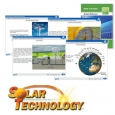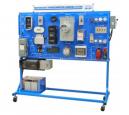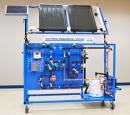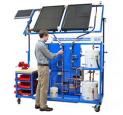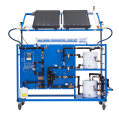Solar PV Installation Learning System
Shortage of Solar Installation Technicians
Industries across all sectors are experiencing a shortage of highly-skilled workers to fill crucial technician roles, and the renewable resources sector is no exception. Despite job growth in recent years, employers in the alternative energy industry still face an ongoing problem with hiring qualified solar installation technicians.
Experts blame advancing technology and a generation not interested in the skilled trades, but the bottom line is the same: the supply of highly-skilled workers simply can’t keep up with industry demand. And the demand for qualified solar installation technicians is rising, as more consumers and businesses apply solar energy in their communities.
It’s no longer a novelty to see solar panels adorning the roofs of homes and businesses. We even see them along the highway powering informational signs and installed by the thousands in huge solar “farms” that generate power for local communities.
As local, state, and federal governments continue to fund and push for more alternative energy projects, demand for highly-skilled solar installation technicians will continue to rise. Amatrol’s Solar PV Installation Learning System (950-SPF1) teaches the installation and commissioning of grid-interactive and stand-alone photovoltaic (PV) systems for commercial and residential applications through a unique combination of eLearning curriculum and hands-on experience with real industrial solar PV components.
Skills Solar Installation Technicians Need
Amatrol’s interactive multimedia eLearning curriculum teaches solar installation topics using text, audio, video, interactive quizzes, and stunning 3D animations to appeal to various learning styles. Learners begin with the basics, such as identifying and analyzing sites for array locations and developing and implementing a site layout.
From there, they steadily advance to more complex concepts and skills, including calculating PV circuit voltage and currents; selecting and installing wiring; and installing and commissioning real-world components in a grid-interactive and/or standalone photovoltaic system for commercial and residential applications.
Learners using Amatrol’s eLearning will find that its comprehensive, detailed curriculum teaches both the foundational knowledge and practical hands-on skills they need to excel on the job. It also teaches installation of both of the most common types of installations: grid-interactive and standalone.
Industrial Realism
To be the best, you must train with the best. That’s why Amatrol pairs an eLearning curriculum with physical training systems that feature real industrial equipment users will encounter on the job. By developing hands-on skills with real equipment, learners will hit the ground running when they enter the workforce.
For example, Amatrol’s Solar PV Installation Learning System consists of a mobile workstation with real solar PV components, including a PV array, micro-inverter, combiner box, communications gateway, charge controller, and remote meter. Tools and consumables, such as clamp meter, digital meter, wire, and conduit, are stored conveniently on the workstation to make installation training more efficient.
The 950-SPF1 has also been designed to teach students and workers key safety skills. For example, relevant safety features include a surge arrestor; PV array and AC disconnect; AC and DC safety switches; and industry-standard lockout/tagout.
Solar Installation Certifications Important
Due to the shortage of highly-skilled solar installation technicians, industry-standard certifications have become more important in recent years. Many employers prefer workers with certifications because they provide evidence that workers have the skills they need.
Amatrol’s Solar PV Installation Learning System provides foundational training to help students and workers prepare for solar certifications from the North American Board of Certified Energy Practitioners (NABCEP), the premier solar technology certification organization.
For example, the 950-SPF1 strongly supports those seeking NABCEP’s PV Installer Specialist (PVIS) certification. Equipped with foundational knowledge and hands-on skills, users of Amatrol’s solar training will be able to earn industry-standard certifications that will put them on the path to a rewarding solar energy career.
Learning Topics
- Mechanical Installation
- Electrical Installation
- Stand-alone PV Systems
- Grid Interactive PV Systems
- Site Assessment and Permitting
- Array Site Analysis
- Circuit Voltage and Current
- Wire Selection and Sizing
- Electrical Connectors
- Conduit and Enclosures
- Inverters
- Converters
- Charge Controllers
- Combiner Boxes
- Power Meters
- Surge Arrestors
Key Features
- Installation Skills Practice
- Two Real-World installation Processes
- Interactive Multimedia Curriculum
- Efficient, Effective, and Safe Training
Additional Requirements
- Installation Skills Practice
- Two Real-World installation Processes
- Interactive Multimedia Curriculum
- Efficient, Effective, and Safe Training
More Information
Agriculture, Food & Natural Resources
![]() Agriculture can be considered one of the oldest industries in th world tracing its origin back 12,000 years. What started with small groups of people in various locations figuring out how to domesticate animals and grow their food has become a multi-trillion-dollar global industry.
Agriculture can be considered one of the oldest industries in th world tracing its origin back 12,000 years. What started with small groups of people in various locations figuring out how to domesticate animals and grow their food has become a multi-trillion-dollar global industry.
Over the last few centuries, sparked by a series of industrial revolutions, significant changes have taken place throughout the industry that has shaped agriculture as we know it today. Machinery has replaced manual processes and hand tools. Additionally, technological advances, including computers and the Internet, have enabled agricultural machines and procedures to be more productive and efficient.
As technology continues to advance, agriculture must keep evolving to ensure that productivity keeps pace with an ever-expanding world population. Today’s agricultural experts need experience with more types of technology than ever before.
Agricultural mechanics is a critical component of robust and relevant agriscience programs. With the right equipment, educators can demonstrate how to construct and repair equipment, buildings, and facilities by following architectural and mechanical plans, show mechanical equipment and power systems, and teach hydraulic and pneumatic systems service and repair.
Plants, farms, and animals are the main functions of agriculture. Still, there are additional opportunities in this field. This career pathway covers a variety of careers - ranging from animal science and veterinary science to metal technologies/welding, oil and gas production systems, and energy & natural resources.
Students need the opportunity to apply physical science principles to their studies with an agricultural mechanics career track that covers:
- Agricultural systems including equipment, power systems, alternative fuel sources and precision technology
- Welding trainers, CNC tables, and hydraulics training systems are all key components to the formula that makes up a robust educational program
- Food Production & Processing Systems
- Natural and Rewable Resource Systems
- Animal Systems, Veterinary Programs




